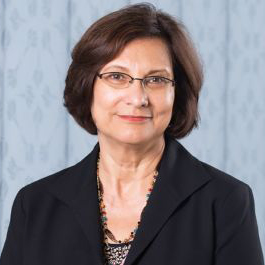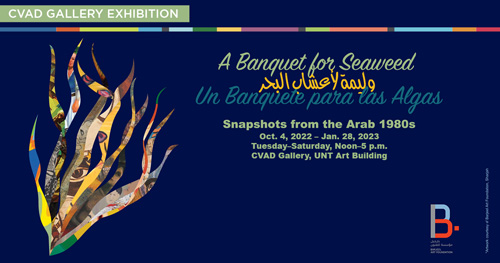Symposium seeks to redress the absence of the 1980s from modern art histories of the Arab East, North Africa, Iran & Turkey regions
"The 1980s: Representational Pressures, Departures and Beginnings"
About the Symposium
Symposium Schedule: Nov. 3 | Nov. 4 | Nov. 5
Concurrent Event: Exhibition
About the Symposium
Nov. 3–5, 2022 | In-person and Virtual Attendance | For virtual attendance, a Zoom link will be sent via a calendar invitation 24 hours before the session.
In-person Location
• Nov. 3 schedule — UNT Art Building | 1201 W. Mulberry St., Denton, TX 76201
• Nov. 4 & 5 schedule — UNT University Union, 1155 University Circle, Denton, TX 76201
Registration Link | Free | Open to the Public
The symposium will offer opportunities to develop the missing knowledge from the Southwest Asia-North Africa region’s art history. In addition, the symposium will contextualize the influence of the 1980s on the region and understand it within a wider global context of developments.
The 1980s in the Arab World, Iran and Turkey was an important decade that witnessed shifts, transitions, endings and new beginnings. It was a turbulent decade that featured horrific moments but also had interesting and enduring developments. These transformations are still active in the region’s current artistic production and cultural memories. For various reasons, however, not much of its art history has been written, according to Nada Shabout, Regents Professor of Modern Arab and Middle Eastern Art at UNT and founding president of the Association for Modern and Contemporary Art.
“We hope people are introduced to art and artists from the region and gain an understanding of the decade’s dynamic impact on the region and the world,” said Shabout, who is one of the world’s leading scholars in modern Arab art and introduced one of the first university art history classes on the subject.
From the Association for Modern and Contemporary Art of the Arab World, Iran, and Turkey: "The 1980s may have concluded more than thirty years ago, but the decade’s transformations remain active in artistic practice across the countries and communities of what we now call the SWANA* region (including but not limited to the Arab East, North Africa, Iran, and Turkey). Thanks to consumer recording technologies, experience and memory took new forms – replay and discontinuous viewing – while cultural criticism began to migrate away from the printed page. To look back on the 1980s is not to be nostalgic so much as to confront the very status of beginnings, departures, and ends. The decade features a list of political crises, invasions, occupations, uprisings, forced displacement, coups, emergent surveillance tactics, militias, and hostages, including the grim events of a catastrophic war between Iraq and Iran, that structure narratives about friendship, solidarity, and loss. And, although the 1980s brought rising enthusiasm for contemporary art as a global phenomenon, artists from the region faced a wave of anti-Middle East sentiment that coded their work as resistant or belated. Still, other transitions, such as those associated with economic “opening,” came to manifest as intense attachments to things. We see 1980s-era commodities come to double as talismans for artists: a very specific paper shredder known as the Schleicher Intimus 007S; the certain cut of a leather jacket preferred by Cairo taxi drivers; a textile collage featuring doubled Jesus figure on leopard print; Doc Martens tied to a performer’s ankles in Brixton; a Nowruz variety show distributed only on videotape.[1] For every promotion of an idealized fusion of “tradition” and “contemporaneity” issued by a cultural ministry, artists have expressed changeable gendered and classed positions in their projects.

Keynote: Sama'an Ashrawi
“The life and times of a Palestinian punk-rocker-turned-hip-hopper in New York City”
Image: Tumblr.com
"Few histories of modern art from the Arab East, North Africa, Iran, and Turkey have devoted attention to the 1980s apart from marking its transitional status.[2] With this conference, the symposium organizers seek to redress the absence.
"To borrow from Edward Said (b. 1935-2003), who wrote in 1982, "What actual affiliations existed between the world of ideas (or images) and the world of brute politics, corporate and state power, and military force?"[3] What are the stakes of specific, situated choices by artists, artist groups, promoters/consumers, or curators and collectors? What strategies are formulated, values mobilized, and expressions codified — by whom and for whom? How to understand the impact of new initiatives, groups, galleries, and institutions, many established by women? What might we learn from this decade, and, conversely, what of its legacy should be jettisoned for the future?"
Symposium Schedule
Thursday, Nov. 3
10 a.m.–4 p.m.: Graduate-student Workshop-participants only
6 p.m.: Award Ceremony honoring Salwa Mikdadi, CVAD Gallery, UNT Art Building, Room 160
- Announcement of the inaugural Research Travel Grant launched by AMCA
- Mikdadi is an art historian and independent curator. She is the co-editor of New Visions Arab Contemporary Art in the 21st Century and was the curator for the first Palestinian Pavilion at the Venice Biennale in 2009. Image: NYU Abu Dhabi
Friday, Nov. 4: UNT University Union, Room 385AB
9:45 a.m.: Opening Remarks
- UNT President Neal Smatresk
- CVAD Dean Karen Hutzel, professor of Art Education
- UNT Regents Professor Nada Shabout, emcee
10 a.m.–Noon Panel 1: Being Seen: 1980s Exhibition Cultures
- Chair: Sarah Rogers, Middlebury College, Vt.
- Discussants: Kurt Rahmlow, principal lecturer, and Mónica Salazar, lecturer, Art History, CVAD, UNT, Denton, Texas
- Defne Kırmızı, Boston University, “Conceptualism Localized: Öncü Türk Sanatından Bir Kesit Exhibition Series in the 1980s Istanbul”
- Joan Grandjean, University of Geneva, Switzerland, “How Two Arab Art Students Started an Artistic Revolution in London”
- Rachel Winter, Eli and Edythe Broad Art Museum at Michigan State University, East Lansing, Mich., and University of California, Santa Barbara, “Alterity, Alternative Spaces, and Representation in 1980s London”
Noon–1:30 p.m.: Lunch
1:30–3:30 p.m. Panel 2: "How the UAE Became the Artistic Crossroads of the Arab World'
- Organized by Mawrid Arab Center for the Study of Art, NYU Abu Dhabi
- Chair: Salwa Mikdadi, NYU Abu Dhabi, UAE
- Discussant: Lisa Owen, professor of Art History, CVAD, UNT, Denton, Texas
- Ala Younis, al Mawrid Arab Center for the Study of Art, NYU Abu Dhabi, “Majid Magazine: how a publishing project in the 1980s shaped the visual culture of the Arab world”
- Dina Taha, al Mawrid Arab Center for the Study of Art, NYU Abu Dhabi, “Methods of Self-Mediation in Hassan Sharif’s Practice”
- Sophie Kazan, University of Falmouth, Cornwall, England, and University of Leicester, England, “Artist Pioneers: Exploring the impact of Art by Emirati artists during the 1980s”
3:45–5:30 p.m. Panel 3: Mediated Experience, Media Art
- Chair: Nada Shabout, professor, Art History, CVAD, UNT
- Discussants: Kelly Donahue-Wallace, professor, Art History, CVAD, UNT, and Denise Amy Baxter, professor of Art History and associate dean for professional development, Toulouse Graduate School, UNT, Denton, Texas
- Anna Levett, Oberlin College, “Ibn ‘Arabi in Sausalito: Etel Adnan in the 1980s”
- Hossein Tavazonizadeh, University of Groningen, Netherlands, “Iranian Interiors in the Narrative Cinema of the 1980s: The Construction of the Memory of Pre-1979 Architecture”
- Anneka Lenssen, University of California, Berkeley, Calif., “On Hearing / Not Hearing Houria Niati’s No To Torture”
6 p.m. Keynote: Sama'an Ashrawi, writer, producer, creative director and multimedia director, known for the TV series "Afrofuturism" and the short film "An Ode to Hannibal Buress"
“The life and times of a Palestinian punk-rocker-turned-hip-hopper in New York City”
Saturday, Nov. 5 | UNT Art Building, Room 223
10 a.m.–12:30 p.m. Panel 4: "The Decade that Changed Iran: Perspectives from the Visual Arts, Film Prose and Poetry in the 1980s"
- Chair: Pamela Karimi, associate professor, Art History, University of Massachusetts, Dartmouth, Mass.
- Discussant: Heidi Strobel, professor, Art History and associate dean for academic and student affairs, and Carey Gibbons, assistant professor, Art History, CVAD, UNT, Denton, Texas
- Blake Atwood, American University of Beirut, “Watching Movies at Home in Iran: Videocassettes and Movie Culture in the 1980s Iran.”
- Pamela Karimi, University of Massachusetts, Dartmouth, “Sites Unseen: State Censorship and the Rise of Alternative Art Forms in Post-Revolutionary Iran.”
- Orkideh Behrouzan, University of London, School of Oriental and African Studies, “The Psycho-politics of Coming of Age in 1980s Iran: Perspectives from Pop Culture”
- Amir Moosavi, Rutgers University, “Elegies for Destruction and Moments of Silence: Early Aberrations in Sacred Defense Literature.”
- Fatemeh Shams, University of Pennsylvania, “Writing Outside Borders: Trauma and Alienation in 1980s Exile Persian Poetry”
12:30–2 p.m.: Lunch
2–3 p.m. Panel 5: National Culture? New Pressures on Afro-Arab Arts
- Chair: Jessica Gerschutlz, associate professor, African and African-American Studies, University of Kansas, Lawrence, Kan.
- Discussant: Neville McFerrin, assistant professor, Art History, CVAD, UNT, Denton, Texas
- Chahrazad Zahi, Boston University, Mass., “Mohammed Kacimi, 1983-2003: Traversées (Crossings)”
- Cynthia Becker, Boston University, Mass., “Seven Walls Revisited (1989): Denis Martinez’s Algeria”
3:15–5:15 p.m. Panel 6: Lebanon's Art World at Home and Abroad in the 1980s: Artistic Production and Reception in Times of War
- Chair: Nadia von Maltzahn, Orient Institute, Lebanon
- Discussant: Jennifer Way, professor, Art History, CVAD, UNT, Denton, Texas
- Monique Bellan, Orient-Institut Beirut, “Continuity and Beginnings? Reading Lebanon’s 1980s art exhibitions through the press”
- Çiğdem İvren, lecturer and research assistant, Modern Arab Art, Islamic Art History and Archeology, Otto-Friedrich University of Bamberg, Bamberg, Germany, “Off the Mainstream: War motifs and the medium of printmaking”
- Jessica Gerschultz, associate professor, Art History, University of Kansas, Lawrence, Kan., “When the Wood is Fragrant, the Bond is Stronger”: Tapestry and Lebanon (the late 1970s-1980s)”
- Nadia von Maltzahn, researcher, Orient-Institut Beirut, Max Weber Foundation, Lebanon, “Fadi Barrage: ‘To think things out in painting’”
Concurrent event with the symposium
 An exhibition: “A Banquet for Seaweed: Snapshots from the Arab 1980s,” curated by Nada Shabout with loans from the Barjeel Art Foundation and other private collections
An exhibition: “A Banquet for Seaweed: Snapshots from the Arab 1980s,” curated by Nada Shabout with loans from the Barjeel Art Foundation and other private collections
Exhibition dates: Oct. 4, 2022–Jan. 28, 2023
CVAD Gallery, Room 160, UNT Art Building
Gallery hours
Tuesday, Wednesday, Friday, and Saturday: Noon–5 p.m.
Thursday: Noon-8 p.m.
Sunday, Monday: Closed
Organizational Sponsors
Office of the President, University of North Texas, Denton, Texas
Department of Art History, UNT College of Visual Arts and Design, Denton, Texas
al Mawrid Arab Center for the Study of Art, New York University at Abu Dhabi, United Arab Emirates
Association for Modern and Contemporary Art of the Arab World, Iran, and Turkey, Nada Shabout, president
UNT International Studies Program
UNT Women's and Gender Studies & LGBTQ+ Studies
UNT World Languages, Literatures & Cultures
Conference Committee
- Jessica Gerschultz, H-AMCA reviews editor, associate professor and graduate studies director, University of Kansas, Lawrence, Kan.
- Pamela Karimi, AMCA treasurer, architect, architectural historian and associate professor of art history, University of Massachusetts Dartmouth, Dartmouth, Mass.
- Anneka Lenssen, lead convener and professor of global modern art, History of Art Department, University of California at Berkeley, Berkeley, Calif.
- Salwa Mikdadi, art historian, curator and art history professor of practice, New York University Abu Dhabi, United Arab Emirates
- Sarah Rogers, AMCA president-elect, independent scholar of modern and contemporary art of the Arab world, Middlebury College, Middlebury, Vt.
- Nada Shabout, AMCA president and professor of art history, Department of Art History, College of Visual Arts and Design, University of North Texas, Denton, Texas
About AMCA
The Association for Modern and Contemporary Art of the Arab world, Iran, and Turkey, AMCA, is a private, non-profit, non-political, international organization. An affiliate organization of the Middle East Studies Association and the College Art Association, AMCA aims to advance the study of this emerging field by creating a network of interested scholars and organizations. We will facilitate communication and cooperation among those in the field by sponsoring conferences, holding meetings, and exchanging information via a newsletter and website. AMCA is a member-based, professional organization.
Footnotes
[1] In order, items mentioned or used by artists Gelare Khoshgozaran, Hassan Khan, Gülsün Karamustafa, Mona Hatoum, and Media Farzin.
[2] One exception may be studies of contemporary art in Turkey and their questions about periodization. See the curatorial project of Istanbul-based curator Merve Elveren for SALT, “How did we get here? Turkey in the 1980s.”
[3] Edward W. Said, “Opponents, Audiences, Constituencies, and Community,” Critical Inquiry 9 no. 1 (Sept 1982): 1-26.
*S.W.A.N.A.: An acronym for the Southwest Asia-North Africa region in place of colonial-period descriptions such as Middle Eastern, Near Eastern, Arab World or Islamic World.






